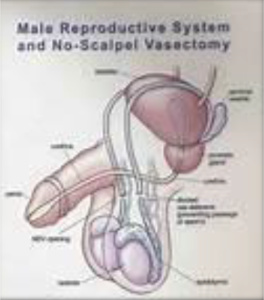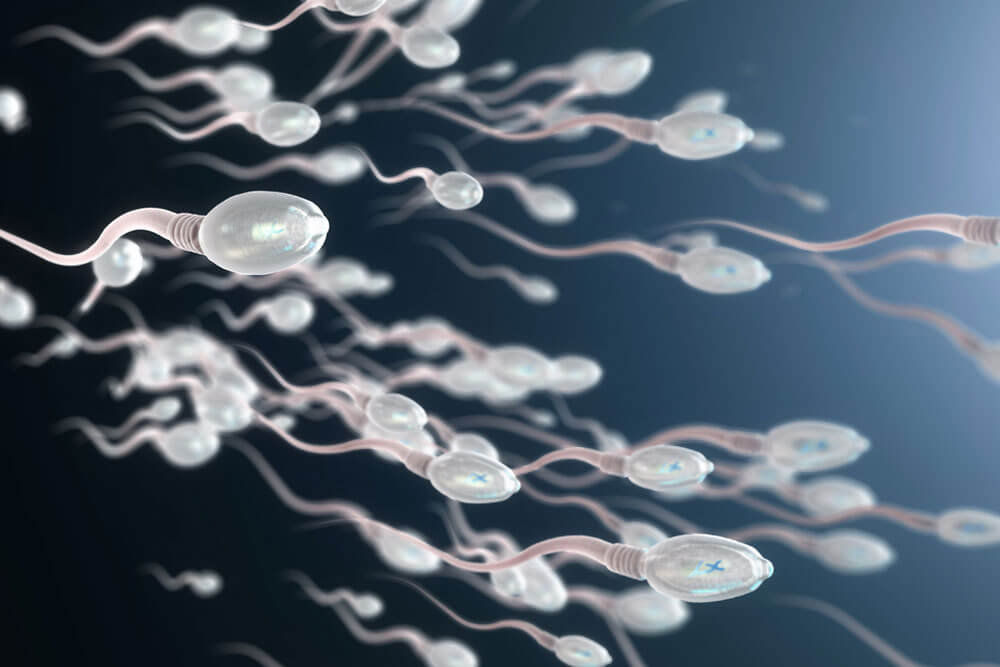Vasectomy is a simple, safe, and effective means of permanent birth control or sterility. Each year about one-half million men in the United States are choosing vasectomy as their method of birth control. It is an important decision because it is potentially irreversible.
Two are two important decisions that you need to make before proceeding with a vasectomy. Number one is that you don’t want to have any more children. This is a decision that you need to make with your partner. A vasectomy may not be for you if you are very young, if your current relationship is not permanent, if you are having a vasectomy to please your partner and you do not really want it, if you are under a lot of stress, or if you are counting on it being reversed at a later day.
Your Reproductive System

- Erection and ejaculation continue as before, but the semen contains no sperm
- The testes still produce sperm and hormones
- The seminal vesicles and prostate secrete the same amount of fluid as before
- The vas deferens are cut, preventing sperm from coming from the penis
- To understand how a vasectomy works, you need to know how sperm is produced, stored and released by your reproductive system.
- The testes are glands that sit inside a pouch of skin called the scrotum. The testes produce tiny sperm (male reproductive cells) and male hormones.
- The epididymis is a coiled tube that holds the sperm while they mature.
- The seminal vesicles and the the prostate gland secrete sticky white fluids semen) to nourish the sperm and carry them along.
- The urethra is the tube in your penis that transports urine and semen. When you have an orgasm, semen (containing 2% sperm) is ejaculated out of the urethra.
- The vas deferens are tubes that carry the sperm from the epididymis to the penis.
Sperm are made in the testes and at the time of ejaculation, travel up through the vas deferens through the prostate and out through the tip of the penis. What vasectomy does in to interrupt the sperm from getting from the testes to the tip of the penis by tying off the vas deferens. Most of the fluid in the ejaculate is made in the seminal vesicles and prostate area. So even after a vasectomy fluid will still come out but it will not have any sperm in it. The testes have two functions, one is to produce the male sex hormone Testosterone. Testosterone is secreted in the blood stream. This will not be affected by the vasectomy. In other words testosterone secretion will be status quo. The other function of the testes is to produce sperm. Sperm will continue to be produced after vasectomy at a much slower rate. These sperm will hang out, will die, and get reabsorbed. We have not found any harmful effects of this ongoing process. Vasectomy will not affect urination, erection, orgasm, or ejaculation, All it will do is to eliminate sperm from the ejaculate.
The Vasectomy Procedure
Vasectomy is a procedure which is performed in Franklin Surgical Center. The procedure will take about 20 minutes. We ask that you read all the information in this article and sign the consent before you go for your procedure. It is important that you read the list of medications not to take. These medications can not be taken a week prior to the vasectomy so it is important that you look at this list well in advance. Tylenol is okay to take at any time before the procedure. If you are on any blood thinners or have a bleeding problem, please let your doctor know. The day of your surgery shower and wash the scrotum with betadine or another antiseptic solution. Bring a pair of clean cotton briefs or a jock strap. Do not wear boxer shorts. You do not need to shave the scrotum.
Surgery
A no- scalpel vasectomy will be performed. This will involve using a special vas-fixation clamp to encircle and firmly secure the vas. The tips of a special clamp are then used to make a small hole in the skin through which the vasectomy is performed. The vas is then exposed with a portion of it being removed. The ends of the vas are clipped and sealed by heat (cauterized) to try to prevent auto-reversal. In a similar fashion the second side is performed. Dr. Ingber may or may not place a suture in the skin. If a suture is used, it may dissolve in 3 to 7 days.
Post- Surgery
After surgery it is wise to go home and place an ice pack over the area. It is vest to stay off your feet as much as possible that evening. It is best to take it easy to keep swelling down to a minimum. If swelling occurs, it may take a few weeks to go away so you are better off trying to prevent it. Please change the dressing daily for the next day or two. Do not be alarmed at some slight oozing or discoloration of the scrotum after the procedure. If there is significant swelling, i.e., 2 to 3 times the normal size, please call Dr. Ingber. There is a doctor available at all times by calling the office. You make take a shower the following evening. Do not use tub baths for 4 days. Do not have intercourse, do heavy lifting, or participate in significant physical activity for about one week, you may want to plan a slightly lighter day than usual until you see how you do. If you are in an occupation that requires a lot of heavy lifting, please ask your doctor for recommendations. As far as pain, Tylenol or Advil are usually enough for the pain. Dr. Ingber may give you a prescription for some pain medicine as well.
You will need to get two negative semen analyses after the procedure. It is important that you use some form of contraception until you get these negative analysis. We ask that you get a semen analysis at 6 weeks and 3 months after the procedure. It takes about 15 ejaculations to clean out all the sperm downstream from the vasectomy. Occasionally these analyses will show some sperm and you will be asked to have further sperm analysis. Again, It is a very important to get these analysis and to uses contraception until you have a negative sperm count.
Risks and Complications
Even with a minor procedure, problems can occur. The following is a list of problems associated with vasectomy. Internal bleeding in the scrotum or infection: Any time an incision is made in the skin there is a small risk of bleeding or infection. Bleeding usually presents as increasing pain or swelling in the scrotum. This usually happens within the first day or two after the procedure. If you experience excessive swelling, please call the office. This is not a problem and usually represents a small amount of blood that has tracked under the skin. Infection usually presents with increased pain, swelling, redness and tenderness of the scrotum, and occasionally fever. If this occurs call your doctor.
Other complications are rare and may occur in the first few months after surgery. Sperm Granuloma is a small lump at the site of the vasectomy. It usually is of no particular significance. It usually causes no symptoms. Occasionally it can be associated with some intermittent discomfort which usually gets better with anti-inflammatory medicines.
Congestion is caused by back pressure on the epididymis associated with the vas being tied off. It usually doesn’t occur but occasionally this discomfort will take few weeks and rarely a few months to resolve. No treatment is usually indicated.
Sperm Antibodies are formed by the body in some men. These antibodies are of no particular significance expect possibly in men who wish to have their vasectomy reversed. Vasectomy reversal is possible and usually requires a few hours under an operative microscope to perform. The data shows if vasectomy reversal or vasovasostomy is performed in the first ten years after vasectomy that 90% of men will get good sperm counts. The pregnancy rate however is only 60%. Some of this discrepancy is possibly attributed to these anti-sperm antibodies. As the time from vasectomy increases the likelihood for successful reversal decreases. The take-home message is that vasectomy is potentially reversible with a pregnancy rate of 60%. Sperm banking is also a possibility before your vasectomy. Few men choose to have this done because it is expensive and doesn’t work that well. Most men choose to rely on vasectomy reversal if they change their mind down the road. It is important to be sure that you don’t want any further children prior to choosing to have the vasectomy done.
Testicular discomfort lasting several years is extremely rare and can be treated. Spontaneous return of fertility or auto reversal occurs very rarely. Numbers reported range from 3% to 1 in 10,000. This can happen if the cut ends of the vas deferens reconnect. Because of this, it is imperative that you get your semen checked for the presence of sperm after the procedure at 6 weeks and 3 months. When you come in for your vasectomy, you will be given two containers for these specimens enabling you to bring them to a lab. It is important that you use some form of contraception until these analyses come back with a negative sperm count. Rarely this auto-reversal can occur after three months even after having a negative sperm count. We don’t know how to identify this extremely rare patient, but some patients choose to have their semen analysis checked at one year. If you wish to do this, please call the office and we will send you a slip.
Prostate Cancer: One study in 1992 showed a possible increased incidence of prostate cancer in men that had a prior vasectomy. There have been numerous studies before and after this study, which have not shown any increased incidence of prostate cancer with vasectomy. There is no physiological reason why the two would be associated. It is the opinion of the American Urological Association that there is no association between prostate cancer and vasectomy.


